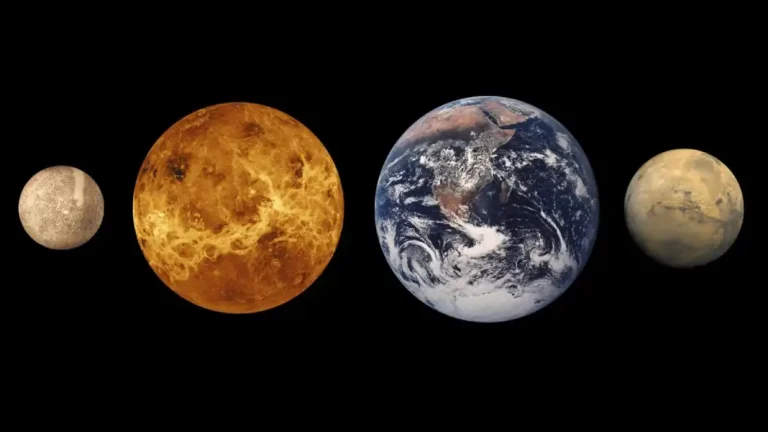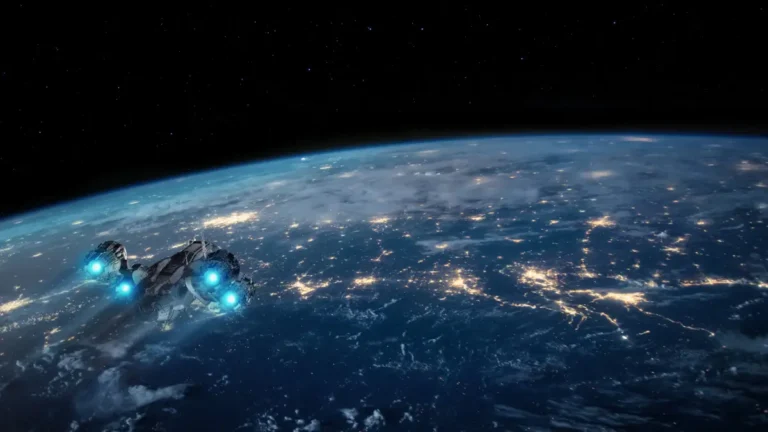Or: How the Universe Farts Life Into Existence
In early summer 2019, the scientific community briefly lost its collective mind. NASA’s Curiosity rover had sniffed something peculiar in the Martian air—methane. Not just a whiff, but a real, respectable puff. The kind that makes researchers bolt upright in their ergonomic chairs and declare: “We found life on Mars!”
After all, methane has long been filed under “stuff produced by living things.” So surely, this meant there were wriggling, belching Martian microbes partying just beneath the surface. High-fives all around. Someone even began warming up the Nobel committee.
But let’s slow the euphoria train.
Mars Express—ESA’s more Europeanly reserved orbiter—had already detected methane from orbit back in 2003. So this wasn’t virgin territory. What made Curiosity’s reading special was its boots-on-the-ground (or rather, wheels-in-the-dust) measurement. It was methane, alright. The real thing. But what if we’ve been asking the wrong question?
This post first appeared in 2020, back when I still entertained hope that rational arguments might sway public sentiment. I’ve since remastered it—sharpened the edges, clarified the threat, and realigned it with the Grimwright ethos: use what works, discard the rest, and always—always—question the narrative. The date remains unchanged as a historical marker. The content does not.
Because here’s the twist: methane is not rare. It’s not exotic. It’s the cockroach of molecules—turn over almost any planetary rock and there it is, grinning back at you.
We’ve found methane in the atmospheres of all the outer planets—Jupiter, Saturn, Uranus, and Neptune—on many of their moons like Titan, Triton, Enceladus, and Charon, and even on distant ice-worlds like Pluto and Sedna. But it doesn’t stop there. Trace amounts have shown up on the scorched surfaces of Venus and Mercury, even on our own Moon. Toss in a few methane-rich interstellar clouds and it becomes clear: methane isn’t rare. It’s the cosmic default.
So unless we believe the solar system is riddled with flatulent lifeforms in -180°C snowsuits, it’s time to consider another possibility.
And that possibility comes not from the stars—but from the deep, chthonic gut of Earth—or of any heavenly ball of rock or gas, for that matter.
Life’s Sloppy Twin: Abiotic Methane
Let’s take a moment. Deep breath. No, not that one—methane is odorless unless it’s spiked with mercaptans. A metaphorical breath.
There are two main types of methane on Earth.
The first is the one you know. You can smell it wafting up from marshes, rice paddies, sewers, termite mounds, cow stomachs, and—on particularly grim days—your uncle Gary’s post-chili aftermath. This is biotic methane. It’s produced by methanogens, microbes with the peculiar talent of turning organic waste into fart fuel. It’s microbial alchemy at its finest.
But then there’s the other kind. The deep one. The methane that seeps, steams, and hisses from geological underworlds where life has never tread.
This is abiotic methane—and it doesn’t need life. Never did.
Formed through chemical reactions between water, carbon dioxide, and minerals like olivine and pyroxene, abiotic methane is forged in high-pressure, high-temperature environments: think tectonic plate boundaries, mantle plumes, and the kinds of places where gods used to dwell before we paved them over with shopping malls.
This methane bubbles up through fractures, percolates into clathrates, and occasionally finds its way into those deposits we call “natural gas.” It’s the ghost in the geological machine. And it’s been here longer than anything with a cell wall.
The Cosmic Soup Kitchen
So let’s rewind the tape a few billion years. No dinosaurs, no plants, no influencer culture—just a simmering, poisonous world.
Back then, Earth was a hellish chemistry set. Volcanoes belched gases, oceans steamed like a fever dream, and the atmosphere was a suffocating stew of methane, carbon dioxide, and hydrogen sulfide. But add some UV light and—voilà!—you get a thick, orange photochemical haze. Not breathable, but rich in organic molecules.
Meanwhile, in the lightless depths of Earth’s oceanic rift zones, something else was bubbling. At Penn State, researchers once found primitive microbes nestled near deep-sea hydrothermal vents, transforming CO₂ into methane and acetate—a sort of vinegar-esque compound. Crude, but effective. Life had a toehold.
Now mix the aerosol haze with the hydrothermal brew. You’ve got methane in the air, carbon-fixers in the sea, lightning in the sky, and time to spare.
Congratulations: you’ve just slow-cooked the first living things on Earth.
Mars Redux – A Reframing
So back to Mars—where our rover found methane and the media lost its mind. If you believe methane equals microbes, then the discovery was revolutionary. But now, with our geological goggles firmly strapped on, it’s clear that Curiosity didn’t find life. It found chemistry.
And that’s the real marvel. Abiotic methane on Mars doesn’t disappoint; it informs. It tells us that the same planetary processes at work in Earth’s early days—ultramafic rock reacting with pressurized fluid—might be happening under the Martian crust right now. That’s not less exciting than aliens. It’s more.
Because what’s more universal than life? The conditions that make it inevitable.
The Titan Template
Then there’s Titan—Saturn’s methane-obsessed moon. Titan is the textbook illustration of abiotic methane doing its thing. It has lakes and rivers made not of water, but of liquid methane and ethane. It rains hydrocarbons. The landscape is carved by rivers of flammable slush. Average temperature? Around -179°C. Cold enough to make dry ice shiver.
If there’s life there, it’s not the kind that clings to biology textbooks. But Titan shows us something more useful: that methane-based chemistry is robust. It builds structure. It cycles. It persists. In an environment where water is rock and CO₂ falls as snow, methane is the working fluid of change.
And again: no cows. No rice paddies. No civilizations belching fumes into the sky. Just geology doing what geology does best—long, slow, blind experimentation. Given enough time, even Titan might surprise us.
Methane: The Unkillable Source
The kicker? These processes never stopped.
Abiotic methane still rises from the Earth’s mantle today. It seeps into the ocean, leaks from fault lines, gets trapped in icy clathrates, and—occasionally—powers your stove. It doesn’t rely on fossilized ferns or dead dinosaurs. It doesn’t need sunshine. It is Earth’s own endogenous breath.
That’s what makes methane different from coal. That’s the petrified residue of decomposed biomass, baked under pressure and time. Methane, by contrast, is a native son of geology. A pure molecule. A true elemental.
And it cycles. Methane that escapes into the atmosphere reacts into CO₂ and water. The water helps form oceans. The CO₂ feeds phytoplankton. Those phytoplankton exhale oxygen, which we then breathe in before we return the favor by exhaling CO₂ once more.
And it cycles so fast that measuring atmospheric methane becomes an exercise in futility. The entire planet exhales it—from land, from sea, from every tectonic seam and hydrothermal crevice. And considering the sheer sprawl of the oceans, we have to ask: are our measurements even capturing one percent of the reality? Probably not. This methane cycle is bigger than we’ve ever dared imagine—vast, continuous, and foundational. One of the deepest-running systems our planet has ever known.
It’s a closed loop. Elegant. Relentless. Antifragile.
Modern Misconceptions – Demonizing the Creator
And yet, in modern discourse, methane has become a villain—painted in the same shade of greenwashed panic as carbon dioxide. We’re told it’s twenty times more “dangerous” than CO₂, that it leaks, escapes, pollutes. But this panic ignores scale, context, and chemistry. It closes its eyes not only to what’s happening on virtually every other rock circling the Sun—but to what’s happening right beneath our feet, and in the air we breathe every second of our existence.
There’s a strange hypocrisy in worshipping natural processes—until they become useful. Hydrothermal vents? Glorious. Methane seeps? Ecological marvels. But the moment we harness those same emissions, the narrative flips: now it’s “unnatural,” “dirty,” “harmful.” As if geology must remain pure and untouched, like a sacred cow, unless we’re documenting it for a BBC special.
This isn’t environmentalism. It’s superstition at best. Large-scale fraud at worst.
True Sustainability – Beyond Sunlight
We live in an age where the word “renewable” has been hijacked by solar panels and bird-shredding wind turbines. But let’s be honest: methane has a better claim to the title. Or pushed to its logical extreme, the others aren’t even renewable—because the materials needed to catch, transform, store, and transport them don’t renew.
But methane burns cleanly, without contraptions. It’s the only true renewable.
Abiotic methane isn’t stored sunlight. It’s not a trickle-down effect of past photosynthesis. It’s a geological process, still ongoing, impervious to weather, politics, or Greta’s disapproval.
That makes it the ultimate sustainable energy source—just not the kind that gets you invited to TED talks.
If wind and solar are nature’s fickle make-believe green pretenders, methane is the full-time job. It predates us, outlives us, and quietly sustains the conditions that made us possible. Fighting methane is not fighting pollution. It’s fighting the source code of life itself.
Philosophical Coda – The War on Origins
And maybe that’s the real tragedy of our time.
We are the only species clever enough to trace our origins back to methane chemistry—and dumb enough to campaign against it. We recoil in horror at CO₂, the very molecule that feeds the base of the food chain. We blame methane for warming the planet, never questioning how our own warmth came to be—or what truly drives it.
In a twisted act of civilizational self-loathing, we have declared war on the breath of the Earth.
But this planet doesn’t care. It made us with methane and CO₂, and it can unmake us with the lack of both. That molecule will still be here, long after we’ve hashtagged ourselves into extinction.
Final Summary: The Planet That Burps Itself Alive
This rock we live on is a methane machine. Has been for over 4 billion years.
That little molecule—so vilified, so misunderstood—isn’t just fuel. It’s ancestry. It’s the wafty fingerprint of Earth’s inner workings. Every time a scientist grimaces at a methane leak, they’re sneering at the very breath that made biology possible.
It’s not fossil fuel. It’s Earth fuel. It’s the planet’s perfume—its natural scent. If you’re serious about environmentalism, you’re a methane fan. Otherwise, you’re just pretending.
And if there’s a single molecule that ties together geology, chemistry, and the improbable emergence of intelligent apes with Wi-Fi, it’s CH₄.




